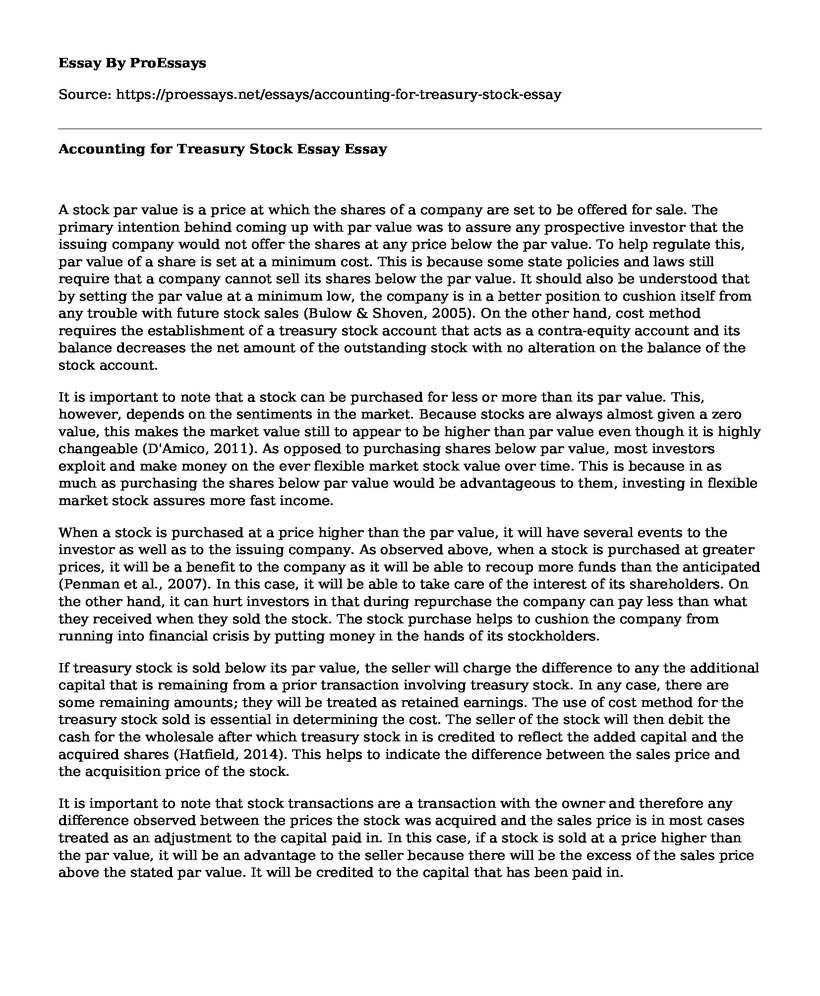A stock par value is a price at which the shares of a company are set to be offered for sale. The primary intention behind coming up with par value was to assure any prospective investor that the issuing company would not offer the shares at any price below the par value. To help regulate this, par value of a share is set at a minimum cost. This is because some state policies and laws still require that a company cannot sell its shares below the par value. It should also be understood that by setting the par value at a minimum low, the company is in a better position to cushion itself from any trouble with future stock sales (Bulow & Shoven, 2005). On the other hand, cost method requires the establishment of a treasury stock account that acts as a contra-equity account and its balance decreases the net amount of the outstanding stock with no alteration on the balance of the stock account.
It is important to note that a stock can be purchased for less or more than its par value. This, however, depends on the sentiments in the market. Because stocks are always almost given a zero value, this makes the market value still to appear to be higher than par value even though it is highly changeable (D'Amico, 2011). As opposed to purchasing shares below par value, most investors exploit and make money on the ever flexible market stock value over time. This is because in as much as purchasing the shares below par value would be advantageous to them, investing in flexible market stock assures more fast income.
When a stock is purchased at a price higher than the par value, it will have several events to the investor as well as to the issuing company. As observed above, when a stock is purchased at greater prices, it will be a benefit to the company as it will be able to recoup more funds than the anticipated (Penman et al., 2007). In this case, it will be able to take care of the interest of its shareholders. On the other hand, it can hurt investors in that during repurchase the company can pay less than what they received when they sold the stock. The stock purchase helps to cushion the company from running into financial crisis by putting money in the hands of its stockholders.
If treasury stock is sold below its par value, the seller will charge the difference to any the additional capital that is remaining from a prior transaction involving treasury stock. In any case, there are some remaining amounts; they will be treated as retained earnings. The use of cost method for the treasury stock sold is essential in determining the cost. The seller of the stock will then debit the cash for the wholesale after which treasury stock in is credited to reflect the added capital and the acquired shares (Hatfield, 2014). This helps to indicate the difference between the sales price and the acquisition price of the stock.
It is important to note that stock transactions are a transaction with the owner and therefore any difference observed between the prices the stock was acquired and the sales price is in most cases treated as an adjustment to the capital paid in. In this case, if a stock is sold at a price higher than the par value, it will be an advantage to the seller because there will be the excess of the sales price above the stated par value. It will be credited to the capital that has been paid in.
Conclusion
Regarding the effect of the above on the net income of the company, it is worth to note that purchase of treasury stock merely is reacquisition of a company's stock. When such transactions are carried out, they tend to reduce the assets as well as the equity of the stockholders and results in a possible legal restriction on the retained earnings (Penman et al., 2007). However, as much as these transactions affect equity of stockholders, there was no involvement of any income statement account in the sale of treasury stock, and therefore there was no single effect on income. In any case, any income statement was involved, the company would further evaluate the transaction process to determine if there is any effect in the income.
References
Bulow, J., & Shoven, J. B. (2005). Accounting for stock options. Journal of Economic Perspectives, 19(4), 115-134.
D'Amico, S. (2011). Flow and stock effects of large-scale treasury purchases. DIANE Publishing.
Hatfield, H. R. (2014). Accounting: Its Principles and Some of its Problems. In The Development of Accounting Theory (RLE Accounting) (pp. 21-29). Routledge.
Penman, S. H., Richardson, S. A., & Tuna, I. (2007). The booktoprice effect in stock returns: Accounting for leverage. Journal of Accounting Research, 45(2), 427-467.
Cite this page
Accounting for Treasury Stock Essay. (2022, Aug 08). Retrieved from https://proessays.net/essays/accounting-for-treasury-stock-essay
If you are the original author of this essay and no longer wish to have it published on the ProEssays website, please click below to request its removal:
- The SSI Federal Income Program - Paper Example
- Research Paper on the Current Status, Requirements, and the Future of Insurance Exchange
- Fama and French and Hou, Xue, and Zhang Essay
- Digital Finance in Nigeria Paper Example
- Essay on Advantages & Limitations of Principles-Based Standards: Financial Accounting Standards Board
- Preferred Stock: Hybrid Security Between Bonds & Common Stock - Essay Sample
- Essay Example on High Turnover Rates at Auxilio Mutuo: Crumbling Institution?







